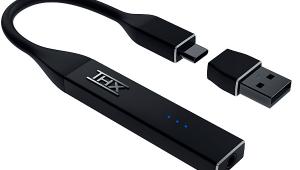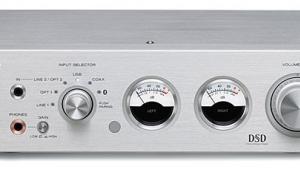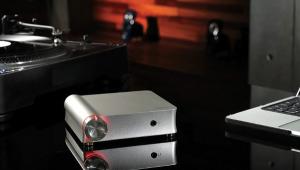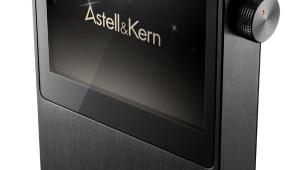Review: Hitachi G-Tech G-Connect

Hitachi's drive division has established a beachhead among thrift-conscious media professionals with it's G-Tech line. The long-awaited G-Connect, however, is a vastly different type of product - a portable wireless media server, meant for the iOS accessory market. It's a cool little box, packed with features.
But what, exactly, is this thing? And who is it for?
Well, it covers a lot of ground for a little $200 box, so first we've got a little explaining to do.
We've looked at Network Attached Storage (NAS, to its friends) a few times in the past. Basically, a NAS solution is a drive with some basic server features that attaches to your network rather than a single computer, making its content available to other connected devices.
Now, largely because of the widespread adoption of the DLNA standard in all kinds of onboard storage challenged devices, from clock radios to AVRs to Smart TVs to (most recently and significantly) mobile devices, it's become more commonplace to find NAS as a media storage solution. Putting aside cloud storage and streaming services for the moment, network storage is, at least in theory, an easy way to give all of the boxes in your home access to your media library.
Early implementations of DLNA were, admittedly, a bit of a pain in the ads to set up and keep working, but the protocol has come a long way, and apps like Twonky and Skifta do make things pretty simple these days, especially on the mobile front.
Apple, historically, has not exactly embraced the media server concept. That's a bit odd, since the company may be selling wireless whole-house entertainment better than just about anybody. Their solutions, however, demand that a Mac be involved in serving up any locally stored content, via Apple's own twist on DLNA, AirPlay. The idea of network attached storage, incorporating some server features, has never really gotten any traction in Cupertino.
And in the context of this discussion, it means that Apple's iDevices can't interface with NAS any more easily than they can, say, use any other external storage.
So enter the G-Connect.
On The Road
What if you've got an iOS device and want to take not just your show, but a whole library of shows, on the road? The cloud isn't for everyone, and what if your destination is off the grid? Or maybe your family isn't exactly consensus-oriented when it comes to what to watch on the go.
Switching gears for a moment, for whatever reason Apple has seen fit to lock down the memory on their mobile devices: you buy a 32 GB iPhone, you've got a 32 GB iPhone forever. You can't expand via a microSD card slot; nor can you add USB drives. Even if you're on Android, SD cards don't exactly provide a lot of storage space for the buck...and increasingly even Android devices (HTC'S recent One series media powerhouses, for example) are following Apple's lead and dispensing with expansion slots.
But now the G-Connect (along with the Kingston Wi-Drive and Seagate GoFlex Satellite) to fill that gap. If you own a large library of content, want to play it back on your mobile device wherever you may be, and might want something that can serve double duty as a home or office media server, the G-Connect might be for you.
It's a 500 GB drive, in a pocket-sized, more-or-less bus powered configuration (it's power-hungry enough that Hitachi throws in an old-school USB Y-cable, so you can use an extra port on your laptop for additional juice; an external power supply is included for standalone usage.) It's got an onboard Wi-Fi transmitter; it can either serve up its onboard content wirelessly to up to five clients, or you can hook it up to your router or modem via a Gigabit Ethernet connector and it'll function as a wireless access point.
It's really in a different class than the superficially similar solutions from Kingston and Seagate; in terms of the sheer amount of functionality it's got under its diminutive hood, it's fairly impressive.
Setup
But is it usable?
Basic setup was simple. Thankfully there's a USB connector on the device for file transfer (USB 2.0 rather than 3.0, sadly, but considering that most low-end NASes lack any USB connection at all, we'll give the G-Connect a pass.). You can also log into the device via a browser-based or iOS application. All methods worked well enough, but for moving large amounts of data the USB connection won out.
Copying data over was simple enough, but the limitations of the device's onboard processor became clear soon enough. The G-Connect took a full day to index a ~250 GB test library, primarily MP3s along with a few feature-length films and several albums worth of high-rez FLACs. That didn't include generating thumbnails (I actually didn't manage to leave the thing on continuously enough to let it complete that task in a single sitting; as a rough estimate I'd guess it took at least several days to generate images for some 60,000 media files.) Data was still accessible during this process, just not graphically represented. I think we can safely say, however, that this thing clearly is meant more for reasonably sized video libraries than for massive audio collections.
Interfacing with the G-Connect is slow - I'm not sure this is a disk limitation (since, as you'll see in a minute, it serves up content to multiple clients just fine), but over Ethernet (even with the onboard Wi-Fi disabled and gigabit Ethernet mode on) admin functions and file transfers were quite pokey. Again, this isn't meant to be a full-fledged NAS unit, but since all of the requisite features and connections are there, it'd be nice to see a little better performance on this front. And it does raise hopes that future software updates might make things sprightlier all around.
I set up the G-Connect as a wireless access point (a simple matter if renaming the device to give it an SSID and creating an admin account). Once it was up, the G-Connect worked near-flawlessly as a music server, serving up separate streams to five clients (three Macs running iTunes, an HTC Amaze handset running Skifta, and an iPad running a number of DLNA clients) with very few glitches (occasionally launching a new track for playback would hang momentarily; this generally took no more than a single retry to fix, and didn't affect other concurrent streams.)
Traveling and want to keep your whole family entertained in a hotel room or summer rental that only has a single Ethernet port? Or one that has no Internet access at all, but having content on tap wirelessly'll keep everyone happy. Why not hook it up to a battery pack or 12v adapter and keep everybody (in the back seat, naturally) supplied with movies for a cross-country road trip. Want to bring a whole lot of your music to the office, but would rather avoid loading it onto your work machine? This might be just the ticket.
You'll note that I wasn't, for the most part, running the official G-Connect app on any of the client devices. While it was perfectly adequate (if a little pokey, as I mentioned above) for administrating drive functions and copying the occasional file; its cataloging of large libraries proved too slow and ungainly to deal with our test library. Playing back video files, and browsing our relatively small movie library worked as advertised with the G-Connect apps, but thousands of mp3s and FLACs were too great a burden for it to bear.
But the fault here clearly lay with the browser-based and tablet apps, not the drive itself. On tablets and various Android smartphones, third party DLNA clients like Skifta worked seamlessly to index and browse our content, as did iTunes running on a couple of Macs, which recognized the device's onboard server as a shared library. (The G-Connect library did take a long while to load on the client machines, however - at least several minutes in most cases.)
I didn't have much success using the G-Connect as a plain old NAS, however. Shutting down the wireless transmitter and enabling a gigabit Ethernet mode is straightforward enough, and I could see the drive on the network thereafter, but content streaming -- to assorted computers, tablets, phones, and set-top boxes -- was hit or miss. I can't recommend the G-Connect for such applications, but since that's not the primary use case for the device, I'm not sure if it counts as a strike against it.
Bottom Line (and Wish List)
I really like the idea of the G-Connect, and I'd love to see a device that did about what this does, but was battery-powered, and could function as a Wi-Fi repeater so it could be dropped into an existing wireless network for easier interfacing with other computers, phones, and devices That'd be a truly awesome little box. And let's get a slicker, faster app with better organization and search functions for large media libraries while we're at it. Seems within reach - the hardware's obviously capable, and the tech is there.
But - if you need something now that will let you carry around and serve up a large amount of content to multiple devices on the go, this may be your box.





























































